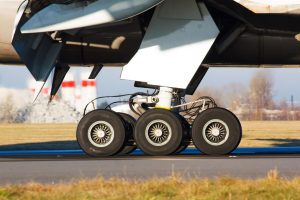
The aerospace industry must meet the net-zero emissions targets by 2050 to contribute decisively to global climate protection efforts. This article examines the implications and potential solutions necessary to achieve these objectives, highlighting the crucial role of high-quality steel in sustainable aircraft designs.
Text by Swiss Steel Group
Although the aviation industry accounts for only around 4% of the total greenhouse gas emissions in the EU, it is considered one of the sectors with the highest increase in greenhouse gas emissions that contribute to climate change. The main reason for this is the disproportionate increase in passenger numbers.
This calls for profound changes in all aspects of the aviation value-add chain, including the use of sustainable materials, alternative propulsion systems, more efficient engines, and the reduction of negative climate impacts while simultaneously achieving efficient, secure, and short supply chains.
The role of steel in aviation
Owing to its many different properties, aviation without steel is inconceivable. Steel is increasingly important not only in terms of quantity but also for its unique applications. It is found in everything from standard components to highly critical parts such as landing gear, engine components, and parts and assemblies that are subjected to high mechanical loads. The aerospace industry uses fifty to one hundred different steel grades, which require a high degree of complexity and expertise in the procurement of steel components. Although lighter-weight materials are being explored, special steels remain indispensable for ensuring the strength and safety of aviation applications.
Following is a discussion of the challenges the steel sector faces.
More efficient propulsion systems and alternative fuels
The engines of the future will improve efficiency and performance while reducing fuel consumption. The most important characteristics are:
Higher efficiency: New engine designs make use of advanced technologies, such as improved fluid mechanics, aerodynamic optimisations, and lower-density materials to achieve greater efficiency. This means that more thrust is produced while consuming less fuel.
Lightweight construction: Aircraft engines can be made lighter by using lighter-weight materials such as carbon fibre composites and newly developed steels. This can significantly reduce the overall weight of the aircraft. To save more weight, higher-strength steels are required to produce smaller components. The demand for steel in aviation is also increasing due to additive manufacturing. Current research is looking at manufacturing steel grades for use in aviation by means of Wire Arc Additive Manufacturing (WAAM). More complex, lighter-weight geometries can be produced, which cannot be manufactured using cutting or forging methods. The weight reductions achieved logically result in lower overall aircraft weight and, thus, lower fuel consumption.
Ultramodern control systems: Advanced control systems and sensor technologies make engine performance control more precise and adaptable to different flight conditions. This produces more efficient combustion and power delivery.
Fan with larger diameter: By increasing the diameter of the fan, engines can take in more air and thus produce more thrust without significantly increasing fuel consumption.
New combustion chamber design: State-of-the-art combustion chamber designs make fuel combustion more efficient, which improves performance and lowers fuel consumption.
Fuels of the future: Switching from fossil kerosine to sustainable aviation fuel (SAF) will make virtually CO2-neutral aviation possible in the future. While aircraft can already be fuelled with SAF, it is not yet readily available.
Optimised propulsion systems: Enhanced effectiveness and efficiency of jet engines will make air traffic eco-friendlier and more sustainable by reducing fuel consumption and emissions. New and existing steels must meet the new mechanical demands and conditions for certification.
To bring about these changes, the hydrogen infrastructure must be significantly expanded in regard to production, transport, storage, and combustion. For this purpose, steel grades are needed that are primarily also resistant to hydrogen embrittlement under high pressure and are unaffected by hydrogen’s higher combustion temperature. This is crucial not just in the aerospace industry, but also in the chemical and steel sectors.

Recyclability, avoiding environmentally harmful materials: Steel is a highly recyclable material that can be used repeatedly. When it comes to aircraft landing gear and components, steel is the preferred material due to its ability to withstand heavy loads and harsh environments. However, coatings are often applied to make steel resistant to corrosive substances. Unfortunately, these coatings often contain harmful substances such as cadmium, chromium (VI) compounds, or zinc-nickel, making recycling difficult and sometimes impossible. As a result, these harmful substances need to be disposed of responsibly to avoid environmental and health risks. European environmental regulations like REACH2 mandate the safe disposal of these materials. To comply and to encourage sustainability, new steel coatings without harmful substances are needed.
Increase in air traffic and aircraft construction: To meet the future demand for steel in the aviation industry, scalable production processes with high process stability are needed.
This is especially important to meet the high-quality standards in aviation and to produce the required steel microstructures reliably and with short lead times without increasing scrap rates.
Specific solutions
- More efficient propulsion systems and alternative fuels – Stainless steel grades, such as 1.4435 or 1.4636 possess ductility even at pressures of over one hundred bar, which meets the safety requirements for the storage of hydrogen. Stainless, high-strength austenitic grades such as XM-19 (1.3964 Mod or 1.4681) or Magnadur 601 are options for hydrogen valves or injectors. Special steel manufacturers like Swiss Steel Group are developing austenitic grades of austenitic grades resistant to hydrogen embrittlement.
- Lightweight construction -Manufacturers are already researching the use of WAAM3 to apply known steel grades to massive components. This is done by layering steel to produce complex, lighter structures on a component surface.
This method reduces weight and lowers manufacturing costs. - Recyclability and avoidance of environmentally harmful materials – As an alternative to high-strength heat-treated steels that require cadmium or ZnNi coating for the corrosive aviation environment, a high-strength stainless Maraging steel could potentially be usedin the future. This steel has comparable material properties and the advantage of not needing any coating due to the alloy layer, making it fully recyclable, resulting in low lifecycle costs. However, until then, research must continue to take all types of steels from lab setups to large-scale industrial production processes. This presents significant challenges regarding suitable large-scale remelting processes and heat treatments that significantly influence steel properties.
- Increase in air traffic and aircraft construction – To ensure that steel production remains profitable and scalable from melting to casting, shaping and heat treatment, seamless process monitoring and control is required. In aerospace applications, the demands on properties, traceability, and tracking are so high that a separate quality management and accreditation standard called NADCAP5 was developed for the industry.
Steel producers with NADCAP accreditation demonstrate that their highly specialised processes are robust and able to deliver the required quality repeatedly. One such process is heat treatment, which finely calibrates steel properties and is essential for its use in aerospace applications.
Facing a dilemma
Steel producers are currently facing a significant dilemma that should not be underestimated.
On the one hand, they must keep pace with the increasing demand from the aerospace sector for production capacities, for example, for steels like 300M, which are commonly used in landing gear.
On the other hand, they must undergo rigorous accreditation processes, like NADCAP.
They must also work on process and product qualification programs in tandem with OEMs and Tier 1 suppliers. A cross-functional, efficient organisation is needed to accomplish this.
- The duration and scope of commercial contracts are impacted by the OEM and Tier 1 order book scales over a period of 9 years.
- To establish long-term contracts and partnerships, a foundation of trust between steel producers and customers is crucial. This trust is built upon technical expertise, stringent monitoring, and traceability that align with the customer’s requirements and quality standards.
- Many producers use simulation tools to predict microstructure properties to improve the properties of steel.
- To build trust with business partners and engage in long-term, costly joint research and development processes, it is necessary to digitise and automate material testing. The combination of quality, reliability, profitability, and speed is ultimately decisive in achieving this goal.
Meeting industry requirements
Swiss Steel Group delivers high-quality steel that meets the demanding requirements of the aviation industry, whether for wing actuators, landing gear, or engines. As innovations, adaptability, and sustainability mark the future of steel in the aerospace industry, such companies will play a decisive role in supplying high-quality steels that meet the demands of the future. This requires stringent monitoring of suppliers. Customers in the aerospace and aviation industries require AS 9100, AS 9120 and NADCAP accreditation, for example.
Deliveries for the aviation industry often require additional, custom customer approvals and the exchange of information with highly qualified production and quality teams, frequently consisting of metallurgic experts who optimally understand steel production processes and have sometimes even designed them.
Conclusion
Decarbonising the aerospace industry is a top priority to meet climate targets. CO2 emissions are to be reduced by at least 55% across the EU by 2030 and by at least 90% by 2040 compared to 1990 levels. Climate neutrality is to be achieved by 2050. Swiss Steel Group plays an important role in supplying high-quality steels for sustainable aircraft designs and construction, and contributes to the development of more efficient propulsion systems and technologies that are even more environmentally friendly.
About this Tech Article
Appearing in the August 2024 issue of Stainless Steel World Magazine, this technical article is just one of many insightful articles we publish. Subscribe today to receive 10 issues a year, available monthly in print and digital formats. – SUBSCRIPTIONS TO OUR DIGITAL VERSION ARE NOW FREE.
Every week we share a new technical articles with our Stainless Steel community. Join us and let’s share your technical articles on Stainless Steel World online and in print.

